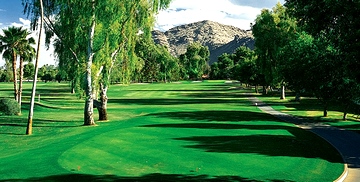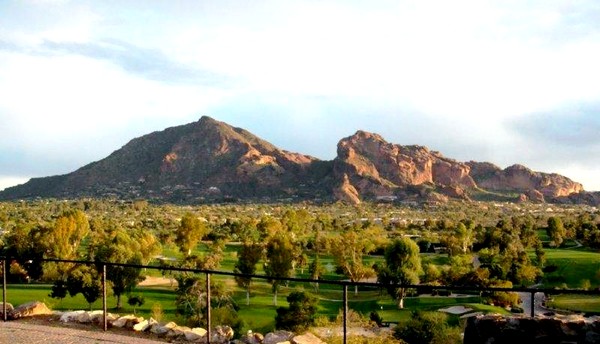Arizona Golf Courses – Orange Tree Golf Resort
Every so often the essence of an epic golf course style from a by-gone era is captured, nurtured and kept fresh so players can turn back the clock and enjoy it all over again.

Orange Tree Golf Club has preserved one of Arizona’s grand parkland-style golf courses and elevated the classic layout by adding today’s modern conveniences. And under the watchful eye of Shelby Futch and his Scottsdale Golf Group, you can be sure Orange Tree will continue to flourish far into the future.
The course is the product of a grand age of golf course design in Phoenix from one of professional golf’s early ambassadors. Designed by Arizona golf legend Johnny Bulla, Orange Tree was originally called Century Country Club and opened in 1957 near the edge of town, on the site of a former orange grove at 56th Street and Shea Boulevard. It’s surrounded by residences now, as the city’s grown a bit since Dwight left the White House.
Bulla traveled and played the tour with his close friend, Sam Snead, and after placing third on the money list in 1941, moved to in Arizona in 1946. Bulla had 16 professional wins and finished, with Lloyd Mangrum, T-2 behind Snead at the ’49 Masters, the first year a green jacket was awarded to the tournament champion at Augusta National.
 Bulla still holds the course record, 61, at Phoenix’s local Papago Municipal layout and legend holds he accomplished the feat twice, once playing right-handed and a second time playing from the left side – only the first score made the newspaper.
Bulla still holds the course record, 61, at Phoenix’s local Papago Municipal layout and legend holds he accomplished the feat twice, once playing right-handed and a second time playing from the left side – only the first score made the newspaper.
Back in those days, Billy Casper was busy winning the 1957 Phoenix Open Invitational. The tournament alternated every other year between two parkland all-turf venues, the Arizona Country Club and the Phoenix Country Club, both private. Other parkland examples from those days still exist: Paradise Valley Country Club opened in 1954 and Moon Valley Country Club in 1958, both are private clubs as well.
But long before designers were saddled with government imposed water-restriction mandates and golf course developers tossed around terms like “signature holes” and built $1 million dollar waterfalls, Phoenix golf courses of this era promised players a wall-to-wall lush, green respite from the surrounding arid desert environment.
The allure of a green all-turf oasis wasn’t a mirage on the horizon, but rather, defined the high-design style of the time and Bulla’s layout followed suit, as did an update by Lawrence Hughes some 20 years later.
 A visit to Orange Tree Golf Club is a refreshing walk-in-the-park day playing a traditional all-turf Bermuda grass golf course on wide and shady tree-lined fairways. Camelback and Mummy Mountain backdrops on several holes, together with accents of tropical foliage, water features and swaying palm trees produces an overall desert-oasis ambiance throughout the day.
A visit to Orange Tree Golf Club is a refreshing walk-in-the-park day playing a traditional all-turf Bermuda grass golf course on wide and shady tree-lined fairways. Camelback and Mummy Mountain backdrops on several holes, together with accents of tropical foliage, water features and swaying palm trees produces an overall desert-oasis ambiance throughout the day.
Orange Tree Golf Club tips out at 6,775 yards, common for courses of this era, and plays to a rating of 70.7, slope 121. Several tee combinations are in play, the most forward are set at 5,704 yards. But be advised, the challenge is not about length at Orange Tree, it’s about controlling your golf ball.
You see, those same stately shade trees which produce the pleasant ambiance at Orange Tree also define the line of play. If you plan to grip it and rip it here, you must be able to shape your tee ball at-will, both to the right and to the left. Launch it on the wrong line and you’ll either catch a tree at lift-off, end up raking one of several strategically placed fairway bunkers, or be stymied by trees when your tee ball comes to rest.
Second shots at Orange Tree must be precise; these are not today’s subdivision-size greens. Orange Tree’s green complexes remain true to their heritage; smallish, well-bunkered and modestly elevated for drainage. The predominate slope in the surface, as expected, is down from back to front so they’re highly receptive to your second shot. However, within their modest confines they provide plenty of opposing-undulation in various tiers which can present you with a 12-footer that asks for a full foot of break. They’re Bermuda too, so pay attention to the grain and make your opponent for the day putt the short ones.
The front-9 plays the shorter of the two and finishes with a traditional 3-hole stretch. No. 7 is pure 3-par golf; 216-yard straight away all-turf carry, bunker front right and back left, elevated green pitched toward you glistening in the sunshine, shady tee box; it’s a great setting to just relax and hit a proper golf shot.
No. 8 defines 4-pars of the era; 414 yards bending right to left around bunkers in the left-hand side of the fairway landing area. The second shot must find a rather narrow green that’s plenty deep but angling away from you, front-right to back-left. The narrow green is protected by a bunker front right and the first water hazard of the day, artfully tucked along the left side of the green; it produces a visually inviting and nerve-testing stage for a well executed second shot.
The par-4 9th is all about strategy, your choices and your execution. It’s only 376 yards and there’s not a fairway bunker in sight, but water shimmers in the distance. It’s reachable from the tee and extends up the right side of the left-to-right sweeping fairway to guard the entire right side of the green. Successfully challenge the water with a driver and you’re left with a gap-wedge approach, the lake is just pretty window-dressing for your enjoyment. Play short of the water off the tee and now your second must carry the lake to reach the green – Your choice.
The back-9 is a bit longer and offers similar strategic choices as water features threaten four holes. At the 408-yard par-4 11th the water protects the front right side of the green. It’s hidden from view if you’re well back in the fairway so before you play your second, take a quick moment to go up and have a look, you’ll be glad you did.
Water lurks short and to the left of the green at the par-3 12th and another lake must be carried with your tee ball at the par-5 13th. On one hand, it takes a fairly significant misfire to find these two hazards, but on the other hand, this is golf and such things do happen from time to time.
The 403-yard par-4 18th at Orange Tree is a strong finisher and one of the best tests of the day. The left-half of the tree-lined fairway ends at a lake approximately 265-yards from the tee, the right-half continues unimpeded to the green, producing a peninsula-style green-complex wrapped by water front, left and rear.
If you choose to play “long ball” off the tee you must fit your drive in the right-half of the fairway and clear of the trees lining that side of the landing area; a short-iron second is your reward. Lay back, to avoid the threat of water on your drive, and you’re left with a much more demanding mid-iron to the modest-sized green surrounded on three sides by a whole lot of water. Many unblemished scorecards are irrevocably scarred right here, so close, yet so far from posting an attractive total.
Orange Tree is a complete test for the highly skilled, supremely playable for all and a genuine chance to savor the grand style of golf course design in Phoenix from days gone by. These are artful golf holes that appear harmless at first look. Upon closer inspection you’ll find that precise lines of play and carefully controlled yardages are required to score well, proving once again that, the more things change, the more they stay the same.
The Arizona Golf Authority “Local Hang” for Orange Tree includes the expansive patio at the club’s Grove Grille and Lounge, as well as Z-Tejas, at the northeast corner of Shea Boulevard and 32nd Street, and Ernie’s Inn, located in the retail complex on the southeast corner of Shea Boulevard and Scottsdale Road.
Read the Arizona Golf Course Review for every golf course in Arizona at www.arizonagolfauthority.com/coursedirectory/; it’s “All Things Arizona Golf” from the Arizona Golf Authority.


